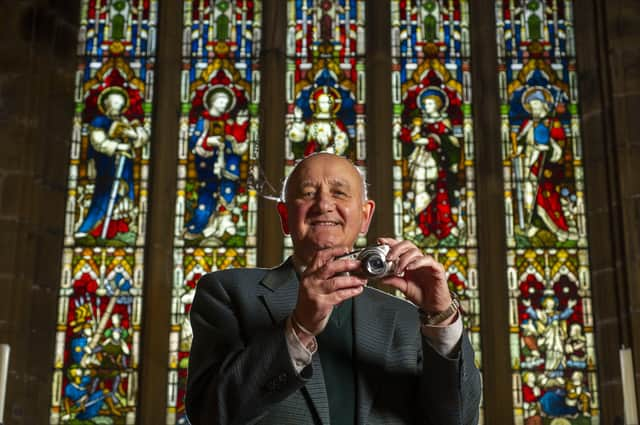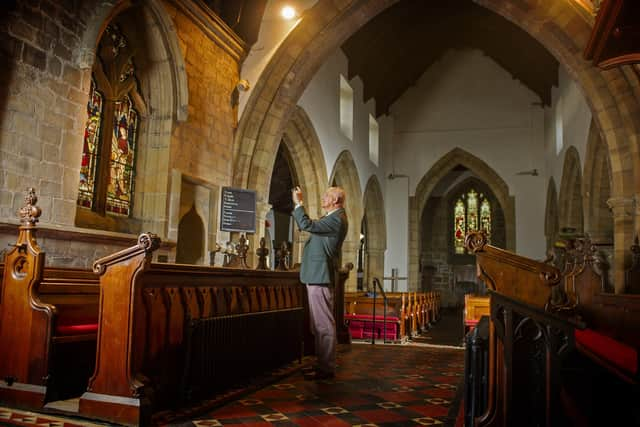From the bible to TV: Yorkshire’s vivid history told in stained glass


It is told not on paper but on window panes, its fragments scattered to the four corners of Yorkshire. Only now has someone attempted to write a table of contents.
The Reverend William Thackray, a vicar retired to Northallerton, is uniquely qualified to document the county’s history in stained glass, having commissioned one of the panels himself. But as he toured the medieval cities and county towns of the Ridings with his camera, the breadth and diversity of the storytelling surprised even him.
Advertisement
Hide AdAdvertisement
Hide Ad“Stained glass is a curious thing. You can walk past windows and hardly notice them. But for every window there was an artist with a purpose,” said Mr Thackray,” who has compiled his photographs of the choicest examples in a self-published coffee-table book.


The scale ranges from the majestic – the 14th century Great West Window at York Minster – to the modest 19th century Dales church of St Margaret at Hawes, which enshrines cheesemaking and the old livestock market.
Nor is stained glass an exclusively ecclesiastical preserve. Some of the most striking modern examples were commissioned for the School of Civil Engineering at Leeds University, where the local artist Jo-ann Eisenberg chose as her subjects the Humber Bridge, the Ribblehead Viaduct and the TV mast at Emley Moor.
Even those windows installed in churches are not necessarily biblical. At the Venetian-styled St John and St Mary Magdalene in Goldthorpe, between Doncaster and Barnsley, the York artist Martha Maguire depicts the union banners and pitheads of the vanished colliery landscape that was once its backdrop.
Advertisement
Hide AdAdvertisement
Hide AdBut it is a more obscure piece of local history on which Mr Thackray was able to shed light in the 1980s, when he was vicar of Bawtry, on the southernmost tip of Yorkshire. His parish took in the village of Austerfield, where William Bradford, one of the founding fathers of the United States, was baptised and from where in 1620 he began his journey to the new world on board the Mayflower. Bradford’s diary is the principal surviving record of the voyage – the 400th anniversary of which should have been a tourism bonanza this year, but with the world in lockdown, saw few modern-day disciples making the pilgrimage.
“Someone had the idea of commissioning a window telling Bradford’s story. I can’t remember what it cost but it didn’t come cheap,” Mr Thackray said. “But we raised funds locally and we had links with some of Bradford’s family in Alaska.”
The parish commissioned the late Yorkshire stained glass artist Sep Waugh, who had created windows for seven Archbishops of York, to produce the panes, which replaced a plain glass window at the Norman church of St Helena. They depict the signing on board of the Mayflower Compact, the first governing document of the Plymouth Colony established by the Puritan settlers.
“That is probably my favourite window of all,” said Mr Thackray. “Americans regard the Compact as one of the key events in the establishment of democracy. So meeting the artist, deciding what was going to go into the window, and then seeing visitors from the USA admiring it made the congregation feel very special. We had a special service attended by someone from the American Embassy.”
Advertisement
Hide AdAdvertisement
Hide AdOf the windows less familiar to him, the one that surprised him most was the 2015 work by the artist Helen Whittaker at the stately and Grade I listed All Saints Pavement in York. It commemorates members of the British forces killed in Afghanistan, including three from the city.
“That one quite took my breath away,” said Mr Thackray, who described his book as having been made “for my own amusement”.
He decided to embark upon the project upon discovering that many of the finest examples depicted local events rather than the scriptures.
York’s architecture is commemorated at the Guildhall in a window commissioned to replace a 17th century work destroyed during the war.
Advertisement
Hide AdAdvertisement
Hide AdAt St Lawrence in Hatfield, near Doncaster, the millennium window includes images of surgical instruments, a flush cistern and a personal computer. And at St Matthias in Stocksbrisdge, the window is a memorial to Samuel Fox, a local weaver’s son who in 1842 founded a steelworks there.
Support The Yorkshire Post and become a subscriber today. Your subscription will help us to continue to bring quality news to the people of Yorkshire. In return, you’ll see fewer ads on site, get free access to our app and receive exclusive members-only offers. Click here to subscribe.
Comment Guidelines
National World encourages reader discussion on our stories. User feedback, insights and back-and-forth exchanges add a rich layer of context to reporting. Please review our Community Guidelines before commenting.